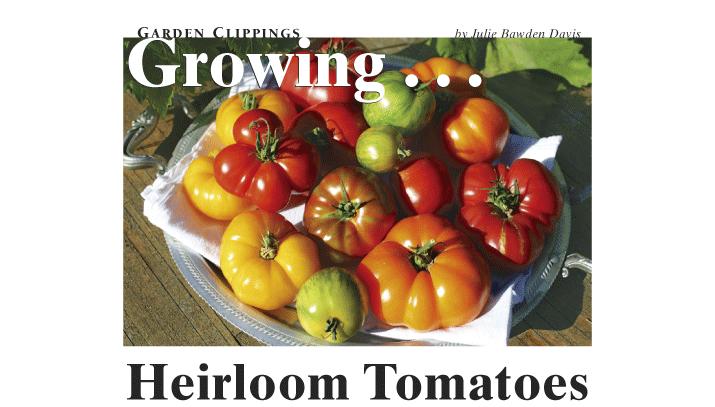
One blistering day several summers ago I opened the door and ushered my sister, Amy, inside. “Is it ready?” she whispered. I nodded and led her to my kitchen table where a one–pound ‘Marianna’s Peace’ heirloom tomato occupied the better part of a dinner plate. Before anyone came along and asked us to share, we quickly sliced into the pink–skinned fruit, which is known for its creamy, sweet flesh and rich, complex flavors.
You’ve probably heard that you haven’t had a real tomato until you’ve tasted a homegrown one. I disagree. You haven’t had a real tomato until you’ve sampled a homegrown heirloom. Just ask Old Towne gardener Erin Sladek, who has grown hundreds of heirloom varieties, many of them from seed.
“With heirlooms it’s all about taste,” she says. “Hybrids may have disease resistance, but heirlooms have flavor–from acidic, to full–bodied, to mild, sweet and everywhere in between.”
“Growing heirlooms is easy,” says Sladek, who shares tips for an abundant tomato harvest.
- Choose full sun. Tomatoes thrive in plenty of light and heat.
- Soil Preparation. “The finest tasting tomatoes come from plants that are grown in rich, healthy, biologically active soil,” says Sladek, who suggests amending heavily with homemade or bagged compost before planting. In each planting hole, apply an organic granular fertilizer according to package directions.
- Planting. Remove all but the top two or three inches of foliage pinching off the bottom leaves. Place the plant deeply into the soil so that only the top foliage is above ground. Roots will form along the buried stem, creating a healthy, strong plant. Leave at least 30 inches between plants as they grow quite large.
- Support. Healthy tomato plants often reach 8 to 10 feet high, so make sure you have strong tomato supports in place when planting.
- Water. After planting, drench tomato plants, and then let the soil dry between watering. Tomatoes do poorly with wet feet. Once established, most do best with a slow and steady weekly soak twice a week during hot spells.
- Container culture. Some small tomatoes and cherry varieties can be grown in containers. Use a big pot that is at least 15 gallons in size. To prepare, place three to four inches of gravel in the bottom of the pot and elevate on bricks for added drainage. Plant in a good organic potting soil. When plants flower, add more fertilizer.
Here is a small sampling of Sladek’s favorite heirlooms:
- Green Zebra: An unusual and exquisite tomato favored by Alice Waters for her restaurant, Chez Panisse, in Berkeley. Two–inch fruit ripens to yellow–gold with green “zebra” stripes. Has an unusual lemon–lime flavor.
- Lemony: Light yellow beefsteak up to 16 oz. from Russia. Sweet, tangy flavor.
- Marianna’s Peace: Pink heirloom from Czechoslovakia that reaches 1 to 2 pounds. Dense, creamy, sweet flesh.
- Paul Robeson: A Russian “black” (dusky dark red) beefsteak with an earthy, exotic flavor and good acid to sweet balance.
- Sophie’s Choice: A Canadian tomato, which is one of the earliest to ripen. Lots of 8–10 ounce fruit that is red–orange outside and deep red inside.
- Sweet Pea: Considered the smallest tomato ever, this deep–red currant tomato has a complex, sweet flavor. One plant produces thousands of fruit.
Julie Bawden-Davis is a garden writer and master gardener based in Old Towne Orange. She is the author of various garden books, including Fairy Gardening and Reader’s Digest Flower Gardening. Reach her at [email protected]
